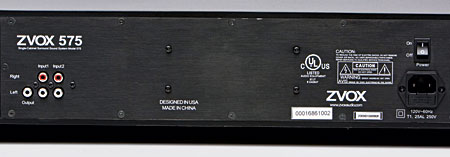ZVOX Z-Base 575 Speaker System Page 2

There are people who don’t believe in break-in, but if any piece of audio gear proves that it’s necessary, it’s the Z-Base 575. It took a few weeks, but eventually the presence region settled down, and the system smoothed out considerably. It wasn’t that I just got used to the extreme presence push. My wife came to like the Z-Base 575’s sound, and she’s usually unforgiving. If the first encounter is poor, the product is finished for her. Luckily, our first date went well. If you buy a Z-Base 575 with its money-back guarantee, give it some time if you don’t like how it sounds out of the box.
Once the Z-Base 575 had broken in, I adjusted the treble and subwoofer controls to bring the system into excellent tonal balance. Just a hint of presence region push remained on all source material. I could lower the volume to bedtime levels and still make out what people were saying.
The low-bass performance was remarkable given the unit’s size and price. It’s surprisingly deep, well controlled, harmonically complex, and free of midbass boom. I’d guess that it went cleanly down to the upper 30-hertz region (see HT Labs Measures). The midbass was somewhat sucked out, which reduced the resonant warmth of the male chest cavity. Keep in mind that placement has a big effect on the final loweroctave balance, so your results may vary. In my case, I had previously used a smaller ZVOX unit in that location and had gotten excellent midbass. Unfortunately, you don’t usually have a choice when it comes to soundbar placement. The speaker goes below wherever the HDTV goes.
The top end was well extended. For the most part, it was clean, with a bit of crispness. In the MSM (mainstream media) that’s a compliment, but in my world that’s a word best reserved for describing a good potato chip. Except for the few shortcomings I mentioned earlier, the Z-Base 575 sounded very well organized rhythmically and harmonically, and the system could play quite loud without dynamic compression in my fairly large bedroom. I made all of these observations with PhaseCue set very low since it has a profound effect on tonal balance as well as on spatiality.
Surround Sound Movies
I ran a Panasonic Blu-ray player’s analog outputs into the Z-Base 575 and watched some familiar scenes from DVDs and Blu-ray Discs. I listened for the general sound quality and PhaseCue’s ability to produce sonic three-dimensionality.

As with all such surround processes, less is more with PhaseCue. Although it made a difference in the analog domain, it never sounded as dry, edgy, or nasty as some digitally processed ones can sound. When the in-phase/out-of-phase balance too greatly favored the out-of-phase material, the sound got a bit gauzy, and images lost body and depth. Dialogue became almost ghostly and difficult to understand. The Z-Base 575 sounded best with PhaseCue turned off, but you lose the out-ofthe-box sensation and the extreme spatiality this speaker is capable of producing.
Set correctly, and assuming you’re sitting centered in front of the soundbar, you can obtain a soundstage that almost magically spreads way beyond the boundaries of the enclosure. You can also get some genuinely believable surround sound response with no appreciable loss of intelligibility or image solidity.
I watched some scenes from Tron that I know as well as, if not better than almost anyone. I listened for some familiar pans, particularly in the light cycle sequence. While the moves weren’t nearly as concrete or definite as you’d hear with conventional surround speakers, the movement was undeniable. It produced the requisite sonic visualization to immerse you within the soundfield. Pans were enhanced as well. The three-dimensional ambience aboard the evil Sark’s ship was extremely convincing, both tonally and spatially. It produced the sensation that there were speakers behind my bed. The very low-frequency components of the artificially created ambience were mostly there, and they created a vast amount of space.
Conclusion
Broken in, and set up tastefully, ZVOX’s Z-Base 575 offers a great deal of technology and performance in a single compact box at a ridiculously low price. It goes incredibly low, produces surprisingly wide dynamic swings, offers excellent dialogue clarity (as long as you don’t overdo PhaseCue), and can create a satisfying threedimensional space. It’s easy to recommend for a secondary bedroom system or for enthusiasts who dream big but budget small. Just don’t expect miracles from a small box.

- Log in or register to post comments




































































